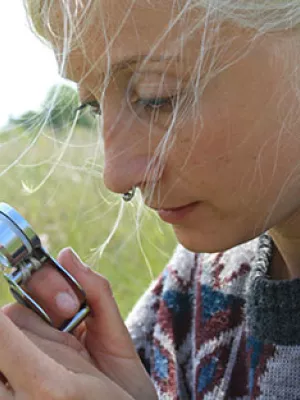
Lina Herbertsson
Researcher

Climate warming and land-use changes drive broad-scale floristic changes in Southern Sweden
Author
Summary, in English
Land-use changes, pollution and climate warming during the 20th century have
caused changes in biodiversity across the world. However, in many cases, the environmental drivers are poorly understood. To identify and rank the drivers currently
causing broad-scale floristic changes in N Europe, we analysed data from two vascular
plant surveys of 200 randomly selected 2.5 9 2.5 km grid-squares in Scania,
southernmost Sweden, conducted 1989–2006 and 2008–2015, respectively, and
related the change in frequency (performance) of the species to a wide range of
species-specific plant traits. We chose traits representing all plausible drivers of
recent floristic changes: climatic change (northern distribution limit, flowering time),
land-use change (light requirement, response to grazing/mowing, response to soil
disturbance), drainage (water requirement), acidification (pH optimum), nitrogen
deposition and eutrophication (N requirement, N fixation ability, carnivory, parasitism,
mycorrhizal associations), pollinator decline (mode of reproduction) and
changes in CO2 levels (photosynthetic pathway). Our results suggest that climate
warming and changes in land-use were the main drivers of changes in the flora during
the last decades. Climate warming appeared as the most influential driver, with
northern distribution limit explaining 30%–60% of the variance in the GLMM models.
However, the relative importance of the drivers differed among habitat types,
with grassland species being affected the most by cessation of grazing/mowing and
species of ruderal habitats by on-going concentration of both agriculture and human
population to the most productive soils. For wetland species, only pH optimum was
significantly related to species performance, possibly an effect of the increasing
humification of acidic water bodies. An observed relative decline of mycorrhizal species may possibly be explained by decreasing nitrogen deposition resulting in less
competition for phosphorus. We found no effect of shortage or decline of pollinating
lepidopterans and bees.
caused changes in biodiversity across the world. However, in many cases, the environmental drivers are poorly understood. To identify and rank the drivers currently
causing broad-scale floristic changes in N Europe, we analysed data from two vascular
plant surveys of 200 randomly selected 2.5 9 2.5 km grid-squares in Scania,
southernmost Sweden, conducted 1989–2006 and 2008–2015, respectively, and
related the change in frequency (performance) of the species to a wide range of
species-specific plant traits. We chose traits representing all plausible drivers of
recent floristic changes: climatic change (northern distribution limit, flowering time),
land-use change (light requirement, response to grazing/mowing, response to soil
disturbance), drainage (water requirement), acidification (pH optimum), nitrogen
deposition and eutrophication (N requirement, N fixation ability, carnivory, parasitism,
mycorrhizal associations), pollinator decline (mode of reproduction) and
changes in CO2 levels (photosynthetic pathway). Our results suggest that climate
warming and changes in land-use were the main drivers of changes in the flora during
the last decades. Climate warming appeared as the most influential driver, with
northern distribution limit explaining 30%–60% of the variance in the GLMM models.
However, the relative importance of the drivers differed among habitat types,
with grassland species being affected the most by cessation of grazing/mowing and
species of ruderal habitats by on-going concentration of both agriculture and human
population to the most productive soils. For wetland species, only pH optimum was
significantly related to species performance, possibly an effect of the increasing
humification of acidic water bodies. An observed relative decline of mycorrhizal species may possibly be explained by decreasing nitrogen deposition resulting in less
competition for phosphorus. We found no effect of shortage or decline of pollinating
lepidopterans and bees.
Department/s
- Botanical collections
- Centre for Environmental and Climate Science (CEC)
- Biodiversity
- BECC: Biodiversity and Ecosystem services in a Changing Climate
- Biodiversity and Conservation Science
- Plant Biology
Publishing year
2018-06
Language
English
Pages
2607-2621
Publication/Series
Global Change Biology
Volume
24
Issue
6
Document type
Journal article
Publisher
Wiley-Blackwell
Topic
- Botany
- Environmental Sciences related to Agriculture and Land-use
Keywords
- bee decline, citizen science, grazing, humification, mycorrhiza, nitrogen deposition, phenology, plant traits
Status
Published
Research group
- Biodiversity and Conservation Science
- Plant Biology
ISBN/ISSN/Other
- ISSN: 1354-1013